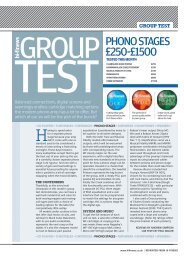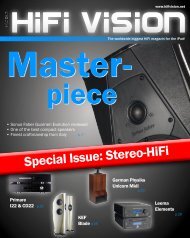PDF file - Primare
PDF file - Primare
PDF file - Primare
Create successful ePaper yourself
Turn your PDF publications into a flip-book with our unique Google optimized e-Paper software.
P R I M A R E<br />
REVIEW: I22 INTEGRATED AMPLIFIER AND CD22 CD PLAYER<br />
This player/converter/amplifier system has proprietary technologies, which feature new power,<br />
filtering, conversion and amplification (see our chapters on technology by image) circuits. The<br />
result is a truly coherent sound aesthetic of great beauty without any auditory fatigue and with many<br />
opportunities to adapt to personal tastes.<br />
Listening Conditions<br />
We first listened to the I22 and the CD22 separately, then together, to determine their best operating<br />
conditions. First of all, and critically, the I22 requires a very long run-in period (as with all switchmode<br />
power supply and switching amplification) of about one week to deliver its full open, analytical<br />
abilities and optimal dynamic capacity.<br />
We stress this point because if you remove the I22 from the box and plug it in, you are unlikely to<br />
hear the potential of this amplifier. After run-in, it requires at least half an hour to stabilize its<br />
performance. After that, the choice of power leads is critical to get the best separation, precision of<br />
timbre and the layering of sounds. We used power cords from MIT, O2A and Silent Wire to replace<br />
the original. Interconnects with an upper-midrange emphasis must be avoided and the most neutral<br />
chosen to expose excellent dynamic capability. Finally, as far as speakers are concerned, we found<br />
that, without changing the sound character, the I22 is capable of driving the most complex loads<br />
with a disconcerting ease. Furthermore the I22 is quite astounding in its ability to retain bass quality<br />
and speed. The remarkable CD22 player was auditioned while making many comparisons between<br />
the various sampling frequencies it offers. The conclusions will go against many preconceived<br />
ideas. In general the 44.1 kHz frequency appears to offer the best spatial coherence, with robust,<br />
well-structured timbres. The higher the oversampling frequency, the more micro-information is<br />
defined, but at the cost of a little control over bass, dynamics, timbre accuracy and stereo width.<br />
Thus, at 192 kHz, rich micro-detail gives an impression of greater transparency: a quite ethereal<br />
character especially from large orchestral works, but with a slightly shortened stereo image width.<br />
To paraphrase the title of a Pirandello play, one is tempted to say "to each his own truth", but be<br />
aware, you must already have speakers with great definition to really appreciate these minute<br />
differences. In the end, we opted to listen at 44.1 kHz where all the parameters appeared the most<br />
balanced to us.<br />
Listen<br />
With the BWV70 Cantata by Bach, the <strong>Primare</strong> set reveals the entire character of the performance<br />
under the direction of John Eliot Gardiner, while distinguishing, with an extremely precise analytical<br />
capability, between the different instruments of the orchestra, in particular the trumpet and the<br />
reverberant oboe, whose pitch is finely in tune, without nasal effect. The chorus, in two sections that<br />
respond to each other, has a very warm tonal togetherness characterised by extremely rich textures<br />
that do not dry out through the upper-midrange. Given the complexity of the message for<br />
reproduction, the <strong>Primare</strong> CD22/I22 system gives a naturally faithful rendition without lapsing into<br />
<strong>Primare</strong> AB • Renvägen 1 • SE - 35245 Växjö • Sweden • Tel +46 470 729215 • www.primare.net





